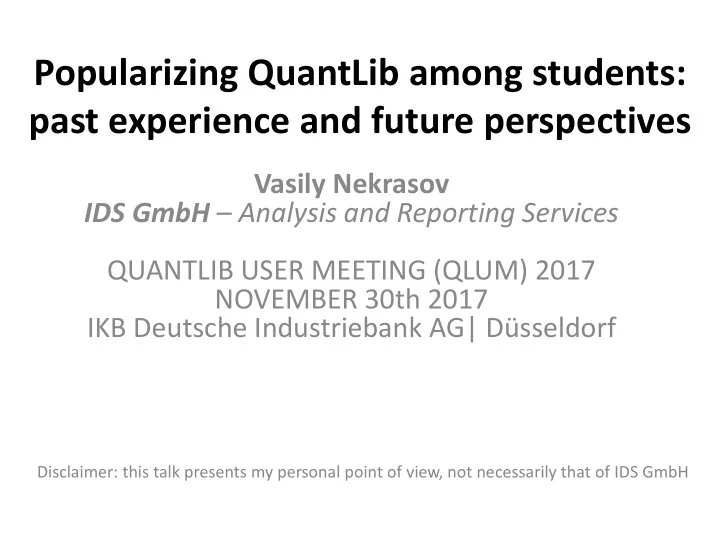

Popularizing QuantLib among students: past experience and future perspectives Vasily Nekrasov IDS GmbH – Analysis and Reporting Services QUANTLIB USER MEETING (QLUM) 2017 NOVEMBER 30th 2017 IKB Deutsche Industriebank AG| Düsseldorf Disclaimer: this talk presents my personal point of view, not necessarily that of IDS GmbH
Students – why bother? • Strategically : Being quant is not as sexy as before (probably BigData and AI are currently what Quantitative Finance was 15 years ago) competition for young talents in financial branch gets tougher (sustainable HR). • Tactically : Werkstudenten (working students) are normally really hard-working (esp. if they are hungry foreigners from non EU-countries). Just guide them and the pay-off will come!
• Personally : Some of today students might become CEOs in a couple of decades. Gratitude is a rare trait* nowadays but probably they will remember their mentor (or somewhat less lofty: „ Once you’ve got that job, the firm will generally be willing to send you on at least one training course. Please consider attending one of mine “ [from Mark Joshi‘s wannabequant-guide]) • Last but not least: „ when a man has anything to tell in this world, the difficulty is not to make him tell it, but to prevent him from telling it too often “ (Bernard Shaw, Ceasar & Cleopatra, Act IV) *we will come to traits once more, although in somewhat other context ;)
Brief on my humble person • First encountered QuantLib in 2007 as a graduate student @ University of Ulm • Developed calculation kernels in C++ for banks and insurance companies after graduation • Tried to grasp QuantLib during my free time and use it as the Z weitrechentool (with very modest results until Dimitri Reiswich‘s tutorials were published) • Dig[ged] deeply in fundamentals (have a look at my Measure Theory & LIBOR Market Model tutorials). Don‘t do it anymore because es rentiert sich nicht
• Have NOT contributed any code to QuantLib [so far], but brought a lot of efforts to make it popular (both among students and employers … and even among mere mortals) • Wrote a successful book „ Knowledge rather than Hope: A Book for Retail Investors and Mathematical Finance Students “, tried to write a book on QuantLib (dropped since there was little payment-willing demand*) *Remorse: I, myself, have still not bought Luigi‘s book, but I will, promised!
• Finally got an excellent job offer from IDS GmbH – Analysis and Reporting Services (subsidiary of Allianz SE) due to my QuantLib enthusiasm! At IDS, we – the GRIPS Team – watch the global fixed income market and use QuantLib[XL] to fit more than 700 yield curves each day. „ Connecting dots “ is far from being trivial… don‘t you believe?!
Well, get back to my student time A „ homework “ I got as I applied to WestLB (now: RestLB) as a junior quant: Market Data Bond 1 Bond 2 Bond 3 Bond 4 Bond 5 Bond 6 Bond 7 Bond 8 Bond 9 Bond 10 Bond 11 Maturity in y 1,7 2,1 3 3,8 4,6 5,6 6,5 7,2 8 9 5,4 Coupon (annual) 4 5 4 5 4 5 4 5 4 5 4 Principal 100 100 100 100 100 100 100 100 100 100 100 Present Value 104,2 110 103 105 100 103 96 103 92 98 ??? Zero rate from 0 to 1 year is assumed constant and equal to 0,02 Question: What is the present value of bond 11 using a bootstrapping algorithm? The maturities m(i) of bonds 1 to 10 may be assumed to be increasing and chosen so that m(i+1)-m(i)<=1 Please use annually compounded rates. Both Excel-based and VBA-based solutions are accepted. Dude, why don‘t you accept QuantLib?!
Why it is so hard to teach students QL • C++ is not programmers lingua franca anymore • Students are really overloaded with their curriculum. • [German University] Professors are often arrogant … „ virgins teaching sex in ivory tower “ (Pablo Triana). Just look!
• Luigi‘s brainpower is enormous … but he might have naively assumed that every QuantLib user is as smart and experienced with C++ as he, himself: „ take the Black-Scholes formula, which is the most basic in a Quantitative Finance library, if you look for it in QuantLib you'll find no single, simple function which gives you the Black-Scholes price for an option. “ ( Open Source Finance 1. QuantLib - An Interview with Luigi Ballabio) Some more examples?!
Michael Mayer (the author of Continuous Stochastic Calculus with Applications to Finance and Project Martingale) was really impressed as I showed him factory functions MyOption::Type type(MyOption::Call); MyOption optionMade=MakeMyOption() .withType(type) .withMat(mat) .withSpot(spot) .withForRate(rf) .withStrike(strike) .withVol(vol) .withDomRate(rd) (which I, myself, learnt from Dimitri Reiswich)
Due to <<Traits>> usage, Doxygen fails to recognize the relationship of PiecewiseYieldCurve and YieldTermStructure
State of art Overload? Overload!
Should be Drawing courtesy Elisabeth Nekrasov I know that object properties should be private… the reality, however, is that subject (i.e. person‘s ) properties are often publicly visible
Questions? THANK YOU FOR YOUR ATTENTION!
Recommend
More recommend